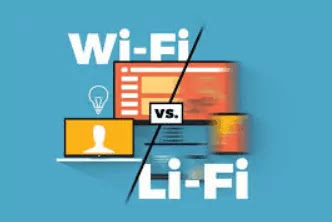WiFi runs our life.
In fact, according to a survey carried out by Direct Line by Opinium
Research online, it is the number one thing that their respondents couldn’t
live without. But no matter where you
are on the planet, you've most likely experienced internet connectivity issues
at some point.
Enter LiFi, a kind of wireless connection that can
be up to multiple times faster than WiFi.
Imagine a society where you can associate with
high-speed internet by simply flicking on your light switch. LiFi is a wireless
optical networking technology that uses LEDs for data transmission. In more
straightforward terms, LiFi is viewed as a light-based WiFi that uses light
rather than radio waves to communicate data. Utilizing light to communicate
information permits LiFi to convey two or three favorable circumstances, for
example, working in zones vulnerable to electromagnetic interference like
hospitals and aircraft cabins and working across higher bandwidth while offering
higher transmission speeds.
The LiFi technology is now being created by various organizations around the globe
LiFi History
The term Li-Fi was first introduced by the University of Edinburgh, however, this technology was first presented by Herald Has, a German professor, and physicist. He presented and showed it at a TED talk in July 2011. He believed lights could go about as wireless switches for Data transmission. His demonstration showed how changes in the amplitude of light at high speeds can be utilized for energy transmission. He demonstrated the use of LED for the transmission of a high definition video and then showed the same video to the audience. He also formed a company later on by the name of pureLiFi. From that point this wireless technology has expanded, presently being deployed in more than 20 countries.
How LiFi work?
We all know how a lightbulb works when an electrical current is applied to an LED light bulb a constant stream of light is emitted from the bulb which we see as illumination since LED bulbs are electronic devices the current and therefore the light can be modulated at extremely high speeds this can be detected by a photodetector and converted back to electrical current, therefore, carrying data this is the nervous system of an internet revolution Wi-Fi doesn't replace your internet service provider you'll still need them to get the Internet to your home or office via wires however, once you have that high-speed connection you can deploy your fast secure Wi-Fi network using power over ethernet or power line communications Wi-Fi offers greater density than many other radiofrequency solutions for example if you have an average Wi-Fi router in your office that provides up to 100 megabits per second and 15 people are connected to that router it means that you might only be able to access or megabits per second however with a live by the network of lights that offer 42 megabits per life even if you had only eight lights in your room those same 15 people could share more than 300 megabits per second that's dense and fast wireless communication real life is also bi-directional full-duplex and high-speed data is transmitted and received at the same time resulting in a really fast reliable user experience especially when doing things like Skype calls video streaming and virtual reality real-life am fully networked that means all the lights in your life network can speak to each other and handover as you move around the space each light even has its own IP address which means that you can offer location tracking and geofencing within your network Wi-Fi a world with unprecedented data and bandwidth.
LiFi Features
SPECTRUM-Providing 1000 times more unlicensed spectrum than traditional wireless communication.
BANDWIDTH-Offering high-speed internet and data transfer which is 10 times faster than the traditional WiFi speed.
SECURITY-Light cannot trespass through the physical environment, enabling secure data passage.
SAFETY-The technology is environment-friendly and has immunity against electromagnetic inferences.
Want to Know About 5G CLICK HERE
Why the world needs LiFi?
Imagine a world with unprecedented data Nand bandwidth every year the world consumes 60 percent more wireless data the space for radio frequencies is becoming older saturated resulting in what is known as the spectrum crunch eventually radiofrequency technology like Wi-Fi and cellular networks will no longer keep up with demand but imagine you have a life don't use radio frequencies it uses the light spectrum which can open up 1,000 times more bandwidth life will be an integral part of the future of wireless networks such as 5g with Wi-Fi we can efficiently use our existing light infrastructures to provide high-speed secure wireless communications Wi-Fi does not interfere with radio frequencies which means you can use it in hospitals power plants petrochemical plants and airplanes the illumination area of Wi-Fi is confined to the area that the light touches which mean that unlike Wi-Fi your signal remains hidden from anyone outside this area, the light is controllable simply shut the door or pull the blinds to protect your network from prying eyes my five a world with unprecedented data and bandwidth be part of the light revolution
LiFi Advantages and Disadvantages
Advantages of LiFi:
- A LED bulb could be your wireless hotspot and a light bulb can be easily found everywhere like in a room, office, vehicle, and other places.
- The speed of data provided by these LEDs is 100 times faster than the WiFi speed.
- It is very efficient in terms of cost and energy.
- Unimpeded by radio interference.
Disadvantages of LiFi:
- The Internet cannot be used without a light source.
- A whole new infrastructure for Li-Fi would need to be constructed.
- The Internet cannot be used without a light source." Yes and no: You need a lighting fixture.
- HoweverLiFi works on dimmed light (dim enough that it appears dark to our eyes), or even on an
- infra-red spectrum, thus invisible to the eye. So you can have LiFi in the dark.
- A whole new infrastructure for Li-Fi would need to be constructed."
Will LiFi replace WiFi?
For the time being, WiFi is still the predominant wireless network. It’s probably safe to say that LiFi will replace it one day, but that day is most likely in the distant future.






2 Comments
Nyc brother
ReplyDeletePretty impressive
ReplyDeleteDon't Spam
Don't Use Harmful or Abusive Word